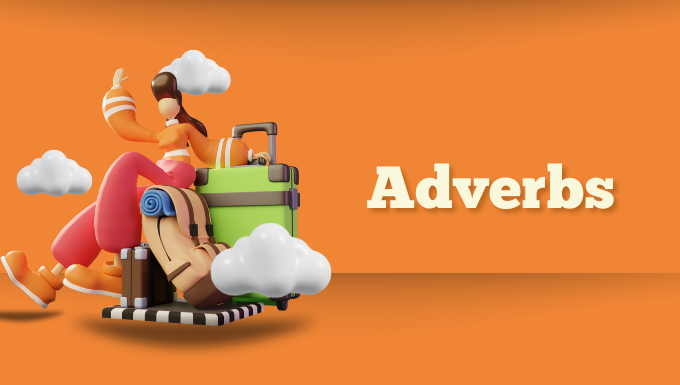
Table of Contents
Introduction
Welcome to our easy-to-understand guide on adverbs, a key ingredient in the English language. Whether you’re a budding writer, an ESL student, or simply looking to polish your grammar, this post will help you grasp the concept of adverbs and use them effectively.
What are Adverbs?
Adverbs are words that modify verbs, adjectives, other adverbs, or entire sentences. They provide additional information about how, when, where, why, and to what extent an action occurs. Think of adverbs as the spices that add flavor to the basic structure of a sentence.
Types of Adverbs
- Adverbs of Manner:
Describe how something is done.
E.g., “She sings beautifully.” - Adverbs of Time:
Tell when or how often something happens.
E.g., “He will arrive soon.” - Adverbs of Place:
Indicate where something happens.
E.g., “They live nearby.” - Adverbs of Degree:
Show how much or to what extent.
E.g., “The soup is too hot.” - Adverbs of Frequency:
Express how often something occurs.
E.g., “I rarely eat out.”
Forming Adverbs
Many adverbs are formed by adding “-ly” to adjectives, but there are exceptions. E.g., “quick” becomes “quickly.” However, words like “hard” and “fast” stay the same as both adjectives and adverbs.
Forming adverbs in English is usually straightforward, especially when dealing with adjectives. Here’s a simple explanation:
Most Common Way: Add “-ly” to an Adjective
- Adjective to Adverb: Many adverbs are created by adding “-ly” to the end of an adjective. This changes the word from describing a noun (adjective) to modifying a verb, adjective, or another adverb (adverb).
- Example: “Quick” (adjective) becomes “quickly” (adverb).
- In “She runs quick” (incorrect), “quick” describes “runs” (a verb), so it should be an adverb: “She runs quickly.”
- Example: “Quick” (adjective) becomes “quickly” (adverb).
- Exceptions to the Rule: However, not all words follow this “-ly” rule. Some words don’t change form between adjective and adverb. Also, some adjectives end in “-ly”, so you can’t always rely on this rule.
- Example: “Fast” remains “fast” as both an adjective and an adverb.
- “He is a fast runner” (adjective) and “He runs fast” (adverb).
- Example: “Fast” remains “fast” as both an adjective and an adverb.
- Irregular Forms: Some adverbs are irregular, meaning they don’t follow the usual patterns and need to be memorized.
- Example: “Good” (adjective) becomes “well” (adverb).
- “She is a good singer” (adjective) and “She sings well” (adverb).
- Example: “Good” (adjective) becomes “well” (adverb).
- Spelling Changes: When converting adjectives ending in “y” to adverbs, replace the “y” with “i” and add “-ly.”
- Example: “Happy” becomes “happily.”
Understanding Adverb Placement
- Position in a Sentence: Adverbs can usually be placed in different parts of a sentence depending on what you want to emphasize.
- “Quietly, she entered the room” (emphasis on the manner of entering).
- “She quietly entered the room” (more neutral).
Remember, forming adverbs is mostly about changing adjectives to modify actions (verbs) instead of nouns. Keep an eye on the context of your sentence, as it can help you decide whether a word should be an adjective or an adverb.
Why are Adverbs Important?
Adverbs play a crucial role in English. They enhance descriptive language, clarify actions, and help convey a clearer picture in the reader’s or listener’s mind. They are particularly useful in storytelling, descriptive writing, and everyday conversation.
Conclusion
Adverbs are an essential part of English grammar, adding depth and detail to our sentences. By understanding and correctly using different types of adverbs, you can significantly improve your communication skills. We hope this guide makes adverbs a bit more approachable and less daunting in your language journey.
Adverbs FAQs
Some frequently asked questions (FAQs) about adverbs are given below to help clarify their role and use in English grammar:
- What are adverbs?
- Answer: Adverbs are words that modify verbs, adjectives, other adverbs, or even entire sentences. They provide additional details about how, when, where, why, or to what extent something happens. For example, in “She sings beautifully,” the word “beautifully” is an adverb modifying the verb “sings.”
- How do you identify an adverb in a sentence?
- Answer: Adverbs often end in “-ly,” but not always. They can be identified by their role in the sentence, which is to add more information about an action or quality. For instance, in “He ran quickly,” “quickly” tells us how he ran.
- What are the different types of adverbs?
- Answer: The main types include adverbs of manner (how), time (when), place (where), degree (how much), and frequency (how often). For example, “slowly” (manner), “yesterday” (time), “here” (place), “very” (degree), and “often” (frequency).
- Can the position of an adverb change in a sentence?
- Answer: Yes, depending on what the adverb is modifying. Some adverbs can be placed at the beginning, middle, or end of a sentence for different emphasis or clarity. For example, “Quickly, he packed his bag” versus “He quickly packed his bag.”